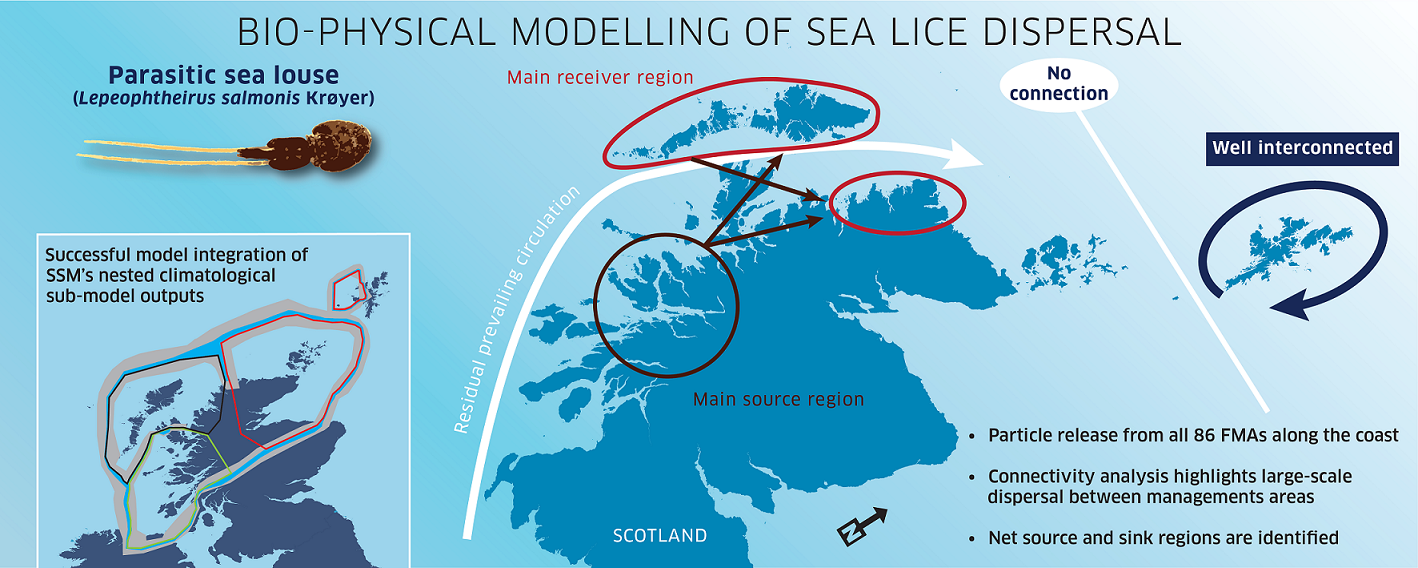Marine
New Reports looking at Sea Lice Dispersal around Scotland
March 30, 2020 by Marine Directorate Communications No Comments | Category Collaborations, Marine Directorate general, Marine Directorate Science, Oceanography, Publications
Two new science reports have been published investigating sea lice dispersal between finfish aquaculture management areas around Scotland. The peer-reviewed article published in Estuarine, Coastal and Shelf Science looks at modelling output at a regional scale with some specific examples. The report for the Scottish Marine and Freshwater Science (SMFS) series provides more in depth information for each region.
Although modelling studies examining sea lice connectivity in Scotland have been published before, this is the first study that looks at the whole coast and islands, instead of individual water bodies, or a relatively small subset of areas. This was done using the Scottish Shelf Model, and its sub-models, to highlight and analyse the large-scale dispersal between Farm Management Areas. These are areas defined by the aquaculture industry primarily to coordinate practices to control parasitic sea lice, which have a large economic impact on the industry and raise significant wild fish conservation and farmed fish welfare issues.
The results of these studies provide information which can help develop more effective parasite control strategies.
Key Headlines from Model Simulations:
- We find a general northward flow of particles representing sea lice from mainland farm management areas, aligned with the prevailing circulation.
- Some regions (Loch Linnhe/Sound of Mull) can be classified as net exporters of sea lice and some (east coast of the Western Isles, the north-west coast) as net importers, according to our simulations.
- A few regions show far reaching connections, for example between the Scottish mainland and the Western Isles.
- Other areas, such as Shetland, appear to be self-contained but internally well inter-connected.
These results were based on an ‘average year’ simulation. Extreme events and year-specific conditions would most likely introduce additional variability and would potentially result in new connections or the absence of some others identified in this study.
(Main image: Graphical abstract describing the main outcomes of our studies (Rabe et al., 2020))
Further Information:
- Interpretation of sea lice connectivity patterns among Scottish Farm Management Areas.
Authors: Rabe B. and A. Gallego. Publication: Scottish Marine Freshwater Science, Vol 11, No 4, 29pp. - Applied connectivity modelling at local to regional scale: the potential for sea lice transmission between Scottish finfish aquaculture management areas.
Authors: Rabe B., A. Gallego, J. Wolf, R. O’Hara Murray, C. Stuiver, D. Price and H. Johnson. Publication: Estuarine, Coastal and Shelf Science.
Partners in this project were: National Oceanography Centre, Liverpool and Jacobs Engineering (formerly CH2M).
Further Reading on Marine Scotland Information website
- Scottish Shelf Model overview
- Typical Scottish Shelf Model Applications
- Scottish Shelf Model Integration
Tags: aquaculture, Coastal and Shelf Science, farmed fish, finfish aquaculture, Loch Linnhe, National Oceanography Centre, oceanography, science, Scottish Marine and Freshwater Science, Scottish Shelf Model, sea lice, Shetland, Sound of Mull, Western Isles, wild fish



Leave a comment